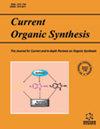Synthesis and Characterization of Novel Polythiadiazoles from Bis-hydrazonoyl Dichlorides and Bis-(methyl-2-arylidene hydrazone carbodithioates)
IF 2.5
4区 化学
Q3 CHEMISTRY, ORGANIC
引用次数: 0
Abstract
Background: Thiadiazoles exhibit a variety of biological activities, including antimicrobial, antiviral, antituberculosis, carbonic anhydrase inhibitor, antitrypanosomal agent, and anticonvulsant properties. Methods: The new polymers are made in two distinct stages. The first stage is to prepare the starting material bis-(methyl hydrazoncarbodithioate) via a condensation reaction between methyl-hydrazinecarbodithioate and dicarbonyl compounds in suitable solvent as isopropyl alcohol. The second stage for the synthesis of the final products poly(1,3,4-thiadiazoles) derivatives is the suitable bis-hydrazonoyl chloride reacted with an equal molar ratio of bis-(methyl-2-arylidenehy-drazonecarbodithioates) in dimethyl sulfoxide, with triethylamine and reflux until the methanethiol gas stopped evolving. FT-IR (Fourier transform infrared spectroscopy), NMR (Nuclear magnetic resonance), and thermal investigation were used to identify and characterize the final products. Results: This work effectively synthesized new derivatives of poly(1,3,4-thiadiazoles) in good yields via the reaction of bis-hydrazonoyl dichlorides with bis-(methyl-2-arylidenehydrazonecarbodithioates). Two routes can be used to explain how the final poly(1,3,4-thiadiazoles) compounds are formed. The first route can be explained by nucleophile substitution of thiolate of bis(methyl-2-arylidenehydrazonecarbodithioates) to the chlorinated carbon of bis-hydrazonoyl dichlorides, followed by removal of HCl (hydrochloric acid) to provide an intermediate (S-alkylated). This intermediate at once leads to an intramolecular cyclo-polycondensation by the exclusion of methanethiol gas to produce our ending products poly(1,3,4-thiadiazoles). The second route concluded [3+2] cycloaddition of 1,3-dipolar cycloadditions of nitrilimines (generated in situ by treatment of bis-hydrazonoyl dichlorides with triethylamine) to thione (C=S) followed by removal of methanethiol to give poly(1,3,4-thiadiazoles) as depicted in schematic diagram. Conclusion: In this article, we reported an efficient method for the synthesis of the novel poly(1,3,4-thiadiazoles) from the reaction of bis-(methyl-2-arylidenehydrazonecarbodithioates) with bis-hydrazonoyl halides.双肼酰二氯和双-(甲基-2-芳基腙二硫代碳酸盐)合成新型多噻二唑并确定其特性
背景:噻二唑具有多种生物活性,包括抗菌、抗病毒、抗结核、碳酸酐酶抑制剂、抗锥虫剂和抗惊厥特性。方法:新聚合物的制造分为两个不同的阶段。第一阶段是通过二硫代肼甲酸甲酯和二羰基化合物在适当的溶剂(异丙醇)中发生缩合反应,制备起始材料二硫代肼甲酸甲酯。合成最终产品聚(1,3,4-噻二唑)衍生物的第二阶段是将合适的双肼酰氯与等摩尔比的双(甲基-2-芳基亚甲基二硫代肼基甲酸酯)在二甲亚砜中与三乙胺反应,并回流至甲硫醇气体停止挥发。利用傅立叶变换红外光谱、核磁共振和热学研究对最终产物进行鉴定和表征。结果:本研究通过双肼酰二氯与双(甲基-2-芳烷基肼基二硫代酸)反应,有效地合成了新的聚(1,3,4-噻二唑)衍生物,且收率良好。最终聚(1,3,4-噻二唑)化合物的形成有两种途径。第一条路线可以解释为:双(甲基-2-芳烷基肼基二硫代酸酯)的硫醇酸盐被双肼酰二氯的氯化碳亲核取代,然后去除 HCl(盐酸),得到中间体(S-烷基化)。通过排除甲硫醇气体,该中间体立即进入分子内环缩聚反应,生成最终产品聚(1,3,4-噻二唑)。第二条路线是通过硝基亚胺(用三乙胺处理双肼酰二氯原位生成)与硫酮(C=S)的 1,3-二极环加成[3+2],然后除去甲硫醇,得到聚(1,3,4-噻二唑),如示意图所示。结论在本文中,我们报告了一种从双-(甲基-2-芳烷基肼基二硫代酸酯)与双-肼酰卤反应合成新型聚(1,3,4-噻二唑)的有效方法。
本文章由计算机程序翻译,如有差异,请以英文原文为准。
求助全文
约1分钟内获得全文
求助全文
来源期刊

Current organic synthesis
化学-有机化学
CiteScore
3.40
自引率
5.60%
发文量
86
审稿时长
6-12 weeks
期刊介绍:
Current Organic Synthesis publishes in-depth reviews, original research articles and letter/short communications on all areas of synthetic organic chemistry i.e. asymmetric synthesis, organometallic chemistry, novel synthetic approaches to complex organic molecules, carbohydrates, polymers, protein chemistry, DNA chemistry, supramolecular chemistry, molecular recognition and new synthetic methods in organic chemistry. The frontier reviews provide the current state of knowledge in these fields and are written by experts who are internationally known for their eminent research contributions. The journal is essential reading to all synthetic organic chemists. Current Organic Synthesis should prove to be of great interest to synthetic chemists in academia and industry who wish to keep abreast with recent developments in key fields of organic synthesis.
 求助内容:
求助内容: 应助结果提醒方式:
应助结果提醒方式:


